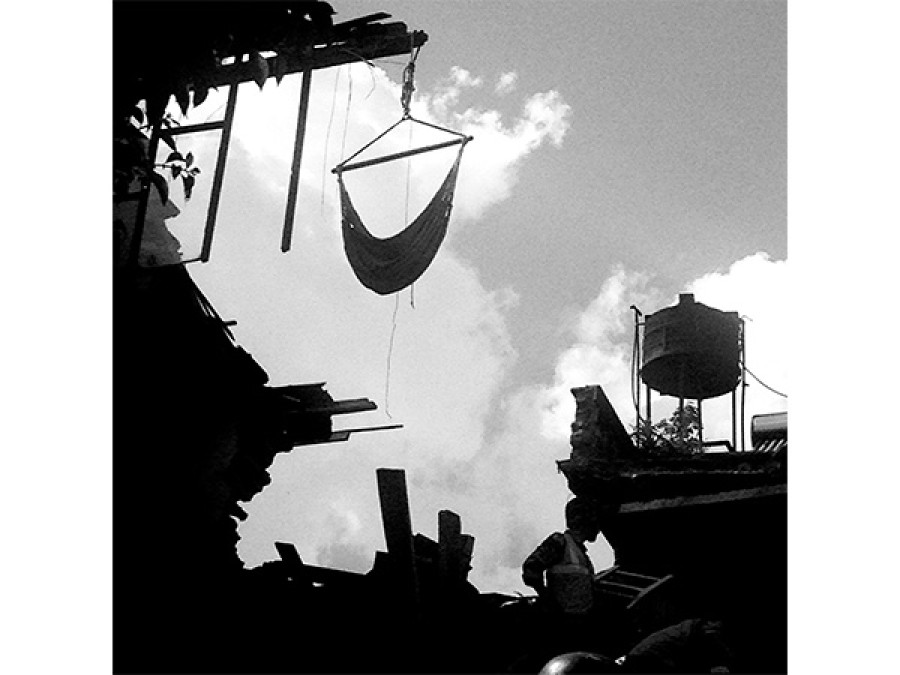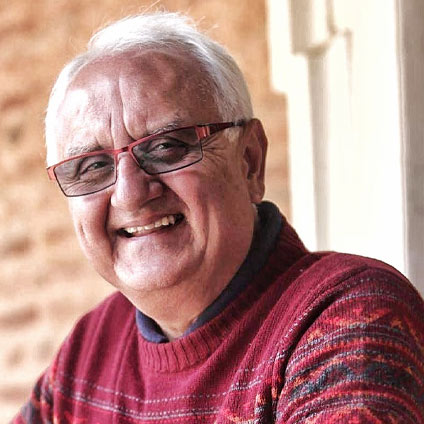Opinion
Dust to dust
The sense of smell is our partner through times of disaster and normalcy
Kanak Mani Dixit
Beyond the still images of death, ruin and triumph (of rescue and resilience), the CCTV and mobile camera footage of falling buildings and crashing hillsides, the brightly coded geological maps showing tremor epicentres and peripheries, and the newspaper columns full of socio-political angst, for me and I am sure many others, the April earthquake was also registered in the chemicals that wafted into the olfactory epithelium.
One can literally smell the earthquake while picking through disintegrated houses, and with the odour imprinted in the brain the mental archive becomes a mixture of the visual and the olfactory. This happens, for example, when I observe the accompanying photograph by art teacher Sujan Chitrakar. When he was growing up in the 1970s in Bhaktapur’s Thalchhen Tole, Chitrakar remembers the German musicologist Gert Wegner renting a house, where a hammock swung in an upper floor.
Visiting Thalchhen Tole after April 25, Chitrakar saw that a side of the particular house had collapsed, but the top-floor wooden beams stood in an overhang. Far above the ground, still hanging from the rafter, was the hammock, swinging to the memory of a departed era. I have marvelled at this image, with the hammock not at all a mundane artefact but one that simultaneously brings to mind the great global value of Kathmandu Valley’s tangible and intangible culture and how the earthquake will now be transforming lifestyles—the odour of these broken dwellings a reminder of the countless generations that have brought us up to here.
The odorant molecules do not have to waft into the nose from the material wreckage of sodden wood, mud, tile and household detritus; a photograph is enough to trigger the receptors.
Distinctive smells
The olfactory sense does seem to be on edge in time of crisis, with the memory keeping extraordinarily well. I remember the exhumation of 18 Maoist cadres murdered at point blank range by the army patrol in August 2003, at Doramba. The smell of the decaying bodies reaching out from the trenches, as I assisted forensic doctor Harihar Osti, went straight from the nostrils to the neurons, never to be dislodged.
Every so often, a particular mix of chemicals, like the one that might come together in one of the Valley’s myriad mounds of uncollected garbage, sends me reeling back to that cloudy saddle of Doramba and the tragedy that rested so heavily on the village.
When I arrived at the site of the Thai Airbus crash high on the Gosainkunda range at 11,500 feet in October 1992, three months after the disaster, the olfactory sensation that I remember was one of oil and metal amidst the pieces of wreckage scattered up and down the steep mountainside. It is this same smell of oil-and-metal that tends to accompany road traffic accidents.
It was a different kind of overpowering smell that attended the rioting and arson following the murder of 12 young Nepali men held hostage in Iraq in August 2004. Manpower companies that were attacked all over the Valley and everywhere one smelt of burning rubber and plastic. When the Singha Durbar burned in 1973, the entire Valley reeked of burning paper.
Where all of it ends, of course, is at the cremation ghat. The prospect of a body being consumed by the flames, the distinctive stickiness of the smoke and soot emanating from the pyre, and the smell of burning flesh—this is probably as close as anyone gets to observing and understanding the finality of death. For the first time in the modern era, during the armed conflict, the Arya Ghat platforms were not enough and last rites were conducted on the sandy riverbed—same as what happened during the April earthquake.
Dust to dust, ashes to ashes, but the crematorium finally nearing completion at Pashupati will take away the visceral nature of the departure ritual that has accompanied Valley dwellers since millennia of habitation. Henceforth, the smoke and smell will be transported up the industrial chimney, and one unique aspect of ‘intangible heritage’ will be no more.
Ashes to ashes
The biblical reference of ‘dust to dust, ashes to ashes’ is to funerals; presumably, the dust refers to burial, and ashes to cremation, but it does not have to be a gloomy commentary on the impermanence of existence. Indeed, one does not have to be a believer to take heart from the expression, especially when you consider that ‘life’ is that interval between when you begin as dust and end as ash.
The period between the beginning and end of consciousness is when the human navigates a life endowed, in comparison to other beings, with a heavier dose of empathy, rationality, the spectrum of emotions and the five methods of sensory perception—sound, sight, touch, taste and smell.
Which brings us back to the olfactory among the five senses and, certainly, the ability to smell is not reserved for the tragic and macabre. Jogging down memory lane, we remember not only the stench but also the aromas, adding richness to our passage.
Kathmandu did not have leavened bread, and hence no toast, when I was growing up. So, the first indelible smell of toast to greet me was in the second-class berth of an Indian Railways bogey. I am also of the privileged generation that experienced the smell of burning coal of the railway stations and marshalling yards, which today’s diesel and electric locomotives can never match.
The lead pencil, too, was a treasured item in mid-twentieth century Kathmandu, when slate and chalk still ruled most classrooms. At St. Xavier’s School in Jawalakhel, in 1961-62, the unravelling corkscrew under the pencil sharpener released the aroma of dry wood. Sharpening pencils still takes me back to Jawalakhel.
Around the same time, I received a koseli of a model aircraft, a De Havilland Comet in shiny red, and that was probably my first smell of plastic, penetrating my olfactory cavity with such impact that it was never to be forgotten.
One might be accused of romanticism and selective memory in claiming that the time of pleasant, natural smells seems nearly over in this galloping age of breath fresheners, colognes and perfumes—with the outdoors these days permeated by the stink of carcinogenic diesel smoke from vehicles and generators, something no invented face-mask seems capable of blocking off.
The Bagmati River for its part,, despite hundreds of weeks of heroic effort at cleanup, continues to emanate foul odours, the one saving grace being that our nasal receptors tend to save us by abandoning stations. The Bagmati smells, but mostly you would not know it does, the only other consolation being that she carries mostly organic sewage rather than the toxic brew of industrialisation.
Unlike the Bagmati, which flows abiral with or without sewage, the earthquake was (hopefully) a once-in-a-lifetime affair. So while we may mentally override the stench at Kupundole or Teku, we are unlikely to forget easily the sights and smells of the 2015 Earthquake. Years hence, when one encounters a whiff that is a blend of attic dust and soot-laden wood, we are sure to be transported back once again to the time of the shaking earth of the April just past, and all the tragedy and resilience of the people and the land that it represents.




 19.12°C Kathmandu
19.12°C Kathmandu










